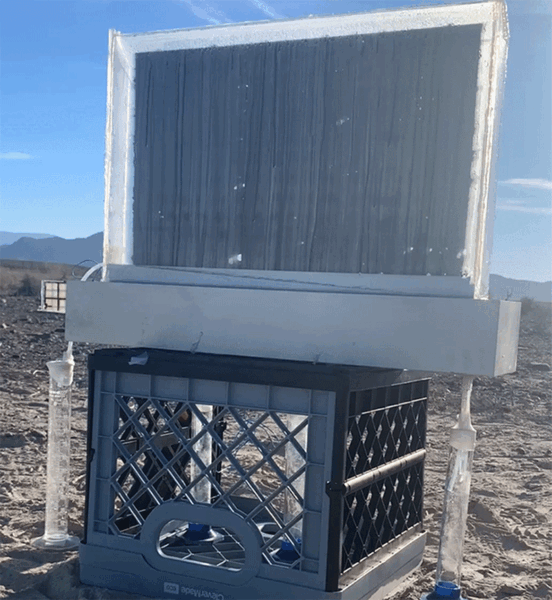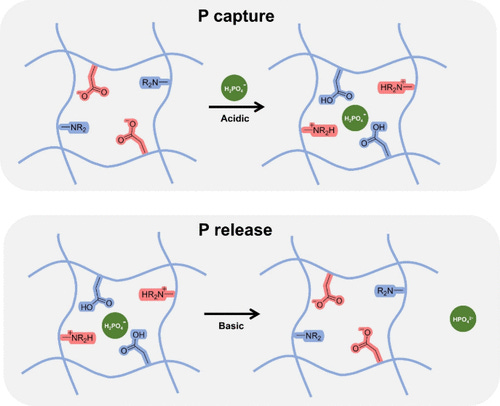#265 - UNEP, Aphresis, Struvite, Fog Harp/Guitar, Window Panels and more...
Water Water Everywhere...
Hey Readers,
As is the case when we skip a week, (apologies for that, but life sometimes gets in the way) we get a larger crop of innovations and news to share with you, and we promise its all about the water. So let’s get into it.
Innovations Roundup
Window panel to extract water from air without any external power source
A research team at the Massachusetts Institute of Technology (MIT) have built a window-sized panel, that is capable of harvesting safe and affordable drinking water from the air and runs entirely on its own without the need for electricity. This device is a black, vertical panel, made from a water-absorbent hydrogel material, enclosed in a glass chamber coated with a cooling layer. The hydrogel resembles black bubble wrap, with small dome-shaped structures that swell when the hydrogel soaks up water vapor. When the captured vapor evaporates, the domes shrink back down in an origami-like transformation. The evaporated vapor then condenses on the the glass, where it can flow down and out through a tube, as clean and drinkable water.
What’s more - Other designed water harvesters have micro- or nano-porous hydrogels, but with embedded salts — typically, lithium chloride — in the hydrogel to increase the material’s water absorption. The drawback, however, is that this salt can leak out with the water when it is eventually collected. Thus the water produced from these designs require additional salt filtering. This MIT team’s design significantly limits salt leakage. Within the hydrogel itself, they included an extra ingredient: glycerol, a liquid compound that naturally stabilizes salt, keeping it within the gel rather than letting it crystallize and leak out with the water. The hydrogel itself has a microstructure that lacks nanoscale pores, which further prevents salt from escaping the material.
The system runs entirely on its own, without any external power source, unlike other designs that require batteries, solar panels, or electricity from the grid. The team ran the device for over a week in Death Valley, California — the driest region in North America. Even in very low-humidity conditions, the device squeezed drinking water from the air at rates of up to 160 milliliters (about two-thirds of a cup) per day. The team estimates that multiple vertical panels, set up in a small array, could passively supply a household with drinking water, even in arid desert environments. What’s more, the system’s water production should increase with humidity, supplying drinking water in temperate and tropical climates.
Enhanced fog collection with a Fog Harp/Guitar
First the history of this idea - Across the Sahel and arid deserts there has been a history of people using nets that are mounted upright, to catch fog droplets as they pass in the wind. The captured water trickles downward and is collected. A single harvesting net can capture several liters of water per day. Today researchers everywhere are working on ways to improve on said design to build scalable systems for fog harvesting in arid conditions. This latest one comes from Virginia Tech, where researchers have improved upon their original fog harp design from 2018 with a model that more closely resembles another musical instrument: a guitar.
Note, the harp design improved the efficiency of water collection upto two to seven times the amount of water as nets. However, it didn’t work well in conditions where water was more prevalent in the air i.e. the team found that a heavily tangled harp did not perform much better than a clog-prone mesh. So in the interest of improving performance under varied conditions, they (realizing that too many horizontal fibers cause clogging but removing all of them causes tangling), included a small number of horizontal cross-supports to combat tangling - somewhat similar to a guitar neck with frets.
Balsa wood-based Atmospheric water sponge
Sticking with pulling water out of air (thin or foggy), a group of scientists led by RMIT University in Australia and Zhejiang A&F University in China have built a device from balsa wood that looks like a sponge, and captures ambient water from the air. This uses solar power to then deposit the water for drinking.
According to them, the technology functioned from 30% to 90% humidity and from 41 to 131 degrees Fahrenheit. These ranges bode well for use in a wide range of environments. They built their wood-based solar-powered atmospheric water harvesting materials (WSAWHM), which we’ve simply called a sponge (sorry?) by delignifying balsa to prepare the wood sponge matrix.
Then incorporating Lithium Chloride (LiCl) as the water-absorbing material, and coating it with multi-walled carbon nanotube ink as the photothermal layer. The presence of natural channels in wood allows rapid water transport and effective absorption-desorption. They also used machine learning techniques to analyze the moisture absorption-desorption process of their sponge (WSAWHM), to develop a calculable relationship between the moisture absorption rate of WSAWHM, environmental factors, and LiCl concentration, which they hope will drive up efficiency of their device.
Removing phosphorous from water
First the Why? - Phosphorus is an essential element for many applications, particularly agricultural fertilizers. Apart from the environmental impact of phosphorous mining, there is the major issue of high phosphorus levels in surface waters – from agricultural runoff, wastewater plants and other sources – contribute to significant water-quality problems such as eutrophication or killing off of aquatic ecosystems. While the idea of filtering phosphorus from contaminated waters is not new, existing technologies rely on potent acids or bases to release the phosphorus once it has been captured.
Now the How? - Enter a team from North Carolina State University (NCSU), who have created a hydrogel that combines two commercially available materials: polyethyleneimine (PEI), which is an inexpensive polymer whose molecular structure allows it to harvest phosphorus from water as the water passes through the material, and polymethyl vinyl ether-co-maleic anhydride (PMVEMA), which is an inexpensive polymer that bonds with the PEI to form a robust gel that allows water to pass through while maintaining its structural integrity.
In testing, the PEI/PMVEMA hydrogel was extremely efficient at removing phosphorus (up to 99%) from contaminated water as it flowed through the material at room temperature. It also efficiently released the captured phosphorus at room temperature using mild bases. Also the hydrogel can then be reused with minimal decline in performance. For example, after being used three times, they could still extract 97.5% of the phosphorus. As their lead researcher says -
“To put this in context, current phosphorus filtration materials cost $20-300 per pound of phosphorus they can capture. Our material costs $23 per pound of phosphorus removed if you only use it once. But you can use it over and over again. If you use the hydrogel twice, the cost drops to $8 per pound of phosphorus harvested. If you use it 50 times, the price drops to less than 50 cents per pound.”
Struvite to remove Ammonia & Phosphates
As mentioned above phosphorus in water = bad, also ammonia in water = harmful algae blooms with severe environmental and economic repercussions. To address this a team of engineers in the Washington University in St. Louis has developed a composite nanotechnology that removes and recovers nutrients from wastewater, subsequently upcycling them as agricultural fertilizers or as biorefinery feedstocks. Like the moisture-absorbing gel in the core of disposable diapers, this team built a hydrogel that can soak up and repurpose excess nutrients. The process uses nanoparticle nucleation—the initial step in forming a solid phase in an aqueous system, similar to sugar crystals forming on a string to make rock candy.
In this case they planted ultra-small mineral seeds in the hydrogel that were created from calcium phosphate and struvite, a mineral composed of magnesium, ammonium and phosphate that binds with calcium and other cations and ions. The ammonia and phosphate bind to the seeds and bulk up the hydrogel. They go on to say that their approach addresses three significant challenges of conventional nutrient removal: a) inefficient collection in traditional methods; b) balancing the removal of both ammonia and phosphate; and c) maintaining consistent removal efficiency in complex water conditions. This method achieves exceptionally low nutrient levels, effectively preventing harmful algal blooms.
News Roundup
First up, an interesting read from the folks at Fast Company that details the issues with our crumbling water infrastructure. As they say - “Water main breaks alone cost Americans $2.6 billion a year in repair and maintenance costs.”
There’s been plenty of news written about new findings of microplastics in our blood, bodies and brains. Well in response to these, a team of scientists has discovered a promising new way to filter microplastics out of the human body by using a method similar to dialysis. Its called Aphresis, and they say it works!
In other good news, Rotary International with technical guidance from the United Nations Environment Programme (UNEP) launched the Community Action for Fresh Water platform, which is a global hub for sharing, monitoring and promoting community-led freshwater protection efforts. It will enable users to discover and track local projects, train citizen scientists, collect data and help close data gaps related to freshwater pollution and ecosystem health.
A Seattle-based social justice organization, has announced a $40 million investment from an unnamed grantmaker to expand clean water, safe sanitation, and menstrual health programs in public schools in Malawi, Tanzania, and Zambia. More power to these anonymous friends of the newsletter.
Apart from the above good news, we have a longer read from Alpha Lo on slowing the spread of the Sahara that may be worth your time.
Also you could go check out the fine people at the Billion Oyster Project who have for years now run efforts to restore NY’s waters and every spring/summer also do water quality testing on NY waterways. You can see their results from Week 5 of 2025 here and Week 6 here. Or sign up to their newsletter here.
That is it for this Friday, until next week,
Peace!









